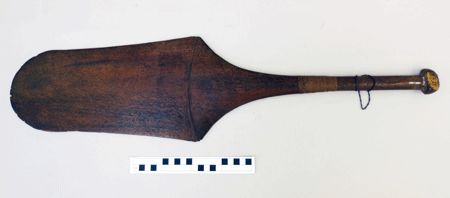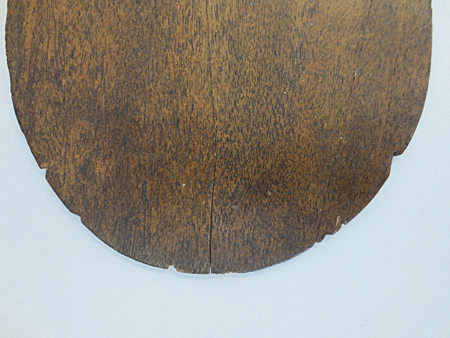This blog post is by Conor Tulloch, our Icon HLF intern at the Pitt Rivers Museum.
What is this and what’s it for?
 |
| 1886.1.1159 Adze, New Zealand |
|
|
|
Smaller and more ornamented than the average Maori adze,
this particular ‘toki’ was probably never used as a tool. Rather it is a
ceremonial weapon, the main function of which was likely to act as a
symbol of the owner’s authority. High-status individuals (rangatira)
could indicate their position on important occasions by carrying such
‘toki poutangata’ [‘the adze that establishes the standing of a person’]
(Neich, 1997).
Beyond this, it has been suggested that ‘toki poutangata’
were also used for the execution of captured enemies, as praiseworthy
spoils of war, as significant objects to be exchanged in treaty, and as
heirlooms, physically connecting its owner with their ‘venerated
ancestors.’ (Keene, 2012).
Where did this one come from?
Naturalists George Forster and his father Johann Reinhold
Forster acquired this ‘toki poutangata’ in New Zealand on Captain Cook’s
second voyage. Though the exact date they obtained the adze is not
known definitively, it appears at least likely to be that described by
Forster on the 4th of June 1773 as, ‘… a hatchet, of which
the blade was of the finest green jadde, and the handle curiously
ornamented with fretwork.’ In his journal entry for
this date Forster writes how the, ‘hatchet’, was sold to them at Queen
Charlotte Sound by Maori from the ‘opposite shore of the northern
island, called Teera Whittee.’
 |
| Map of Queen Charlotte Sound, New Zealand |
 |
| A similar adze illustrated in Cook's account of the Second Voyage |
What’s it made from?
Nephrite - the blade of the ‘toki’ is made of nephrite, a form of
Jade. It is a hard, fine-grained, greenish mineral that, in New Zealand,
is only found in particular waters of the South Island. Known as
‘pounamu’, nephrite was a highly valued and highly traded commodity in
Maori life and was used to make a variety of tools, weapons, and
ornaments.
 |
| 1886.1.1159 - detail of nephrite blade |
Flax -the type of flax found in New Zealand was essential to the
Maori way of life. The common forms of this plant (Phormium sp.) were used
variously in medicine, clothing, and tools. Here, the flax makes up the
lashing that secures the nephrite blade to the wooden haft.
This type of flax, closely related to the day lily or Hemerocallis, and thus unrelated to linen flax, was greatly praised by George Forster in his journal entries.
Haliotis shell - the inlaid eyes of the two carved faces
in the handles are both made from shaped pieces of Haliotis shell. Also
known as abalone, Haliotis is a genus of sea-snail endemic to New
Zealand. Its iridescent appearance is somewhat similar to
mother-of-pearl and is a common decorative feature in Maori craft.
 |
| 1886.1.1159 Detail of eye |
How was it made?
Blade - the blade of this adze has been shaped into a long, thin
rectangle. The hewing end is beveled to an edge while the butt-end has
been cut to accommodate the toe of the wooden haft. A perforation has
also been drilled at this end to allow the lashing to pass through.
Perforations like this are not found on adzes used as a working tool,
probably as it weakens the structure of the nephrite and so shortens the
useful life of the tool (Pearce, 1971).
A way of shaping nephrite was by sawing and filing with
sandstone or greywacke flakes. Using these flakes with the addition of
water, a groove can be incised into the nephrite. Into this groove,
quartz sand, which is harder than the nephrite, can then be added to
speed up the sawing process. This action would continue until the
saw-line was deep enough to snap the nephrite cleanly or until it met an
opposing groove, sawed from the other side.
Once the general shape of the ‘toki’ blade was
established, the fine-grain of the nephrite would be polished on
grindstone slabs (hoanga) of sandstone or mudstone. The hewing end of
the blade would also be fashioned this way. One author describes the
process in the absence of rotary grindstones:
‘He takes his slab of sandstone to the nearest stream or
pool, and places it therein in a slanting position, the lower end being
under water. He "squats" down at the upper end, and rubs his implement
up and down on the stone in a longitudinal manner, each downward
movement taking the edge and part of the blade well under water. This
assists the grinding process, and saves the operator the trouble of
obtaining water and frequently pouring it on the surface of his
grinding-stone.’ (Best, 2011)
The drilled hole would probably have been achieved using a
weighted ‘stone-tipped pull-cord drill,’ the alternating rotation of
which would produce a conical hole. This would meet with an opposing
hole, drilled from the other side, to form an hourglass shaped
perforation.
Lashing - the flax lashing here appears in two forms. In the photo
below it can be clearly seen that the flat, straight plant fibres on the
left have undergone fewer processes than the twisted, plaited fibres on
the right.
 |
| Detail of lashing |
These fibres are obtained from the leaves of either of two
indigenous Phormium species (Phormium tenax and P. coelensi, syn P. cookianum). The flesh is removed from the broad leaves
using a sharp shell.
The flat fibres here are bound around the blade to the
foot of the handle with a turn of cord running between the butt of the
adze and the foot. The plaited cord however belongs to a different
system of lashing and is not attached in any way to the flat fibres.
Rather, the plaited cord runs through a hole in the foot of the handle
that corresponds with the perforation in the adze. The cord is then
passed through the nephrite from opposite directions and tied off at the
top.
Haft - The haft (kakau toki) of this ‘toki poutangata’ is made of
wood, the exact species of which had not been identified in this
example. Its form, however, is common to Maori adzes and is well
documented. The angle of the foot to the shaft is acute, having been
derived from a secondary branch of a tree. A section of the primary
branch would have been cut from the tree and then carved down to create a
foot for the adze-blade (Best, 2011).
In the case of this haft, there is a perforation running
through the width of the foot. This is unusual for adzes functioning as
working tools (the blades of which are usually lashed to the foot
directly without perforation) but is often seen in ‘toki poutangata’.
What does the decoration mean?
There are various assertions on the meanings of the
curvilinear patterns and distinctive figures found in Maori carving.
However it is misleading to give any definite interpretations. One publication on a New Zealand government website
accounts much of the meaning given to these carvings to, ‘the
perpetrator of [a] clever and successful hoax’, a member of the Arawa
tribe who, ‘obligingly,’ misinformed the author of the book Maori
Symbolism. Instead it is suggested that much of the carving was purely
decorative and that the symbolism relating to the figures has been
either exaggerated or was already lost by the time Europeans arrived.
(McLintock, 2009).
Regardless, the fact remains that there are recurring
patterns and motifs in Maori carving, some of which are present on this
‘toki’:
Spirals are one of the most common motifs in Maori relief
carving. These are usually not single spirals but are formed of
interlocked pairs as illustrated below. One form of spiral here is the
‘rauru’, a curved variation of the ‘rauponga,’ which is a band of
dog-tooth notches bordered with parallel grooves.
 |
| Carved decoration on adze |
In addition there are simple incised notches, more
rectilinear bands of ‘rauponga’, and, of course, the two abstracted
figures on the foot. Such abstracted figures are seen throughout Maori
carving and it has been suggested that the basis of design in this
tradition is built out of the human form. It can be seen that the
anatomical features of the figure shown here is composed of distinct
decorative elements. The four-fingered hand, splayed across the belly,
is formed of simple rectilinear bands, while what appears to be the legs
and arms are variations of the ‘rauru’.
 |
| Figure carved on heel of adze |
 |
| Figure carved on base of handle |
Best, E. (1912) '
Stone Implements of the Maori', Wellington: NZETC
N. Thomas and O. Berghof (Eds) 'A Voyage Round the World, George Forster' Volume I, Honolulu: University of Hawai’i Press, 2000
Kaeppler, A. L.'“Artificial Curiosities”, An
Exposition of Native Manufactures, Collected on the Three Pacific
Voyages of Captain James Cook, R.N.' Honolulu: Bishop Museum Press, 1978
Keene, B. (updated 2012) Pounamu – Jade or Greenstone – Symbols of Chieftainship, Te Ara – the Encyclopedia of New Zealand
Neich, R. 'Pounamu, Maori Jade of New Zealand', Auckland: David Bateman Ltd, 1997
Pearce, G.L. 'The Story of New Zealand Jade, Commonly Known as Greenstone', Auckland: Collins 1971
Swarbrick, N. (updated 2012) Flax and flax working - Māori use of flax, Te Ara - the Encyclopedia of New Zealand
McLintock, A.H. (updated 2009) Meaning and Symbolism, , Te Ara - the Encyclopedia of New Zealand
URL: http://www.TeAra.govt.nz/en/1966/maori-art/page-6


















































